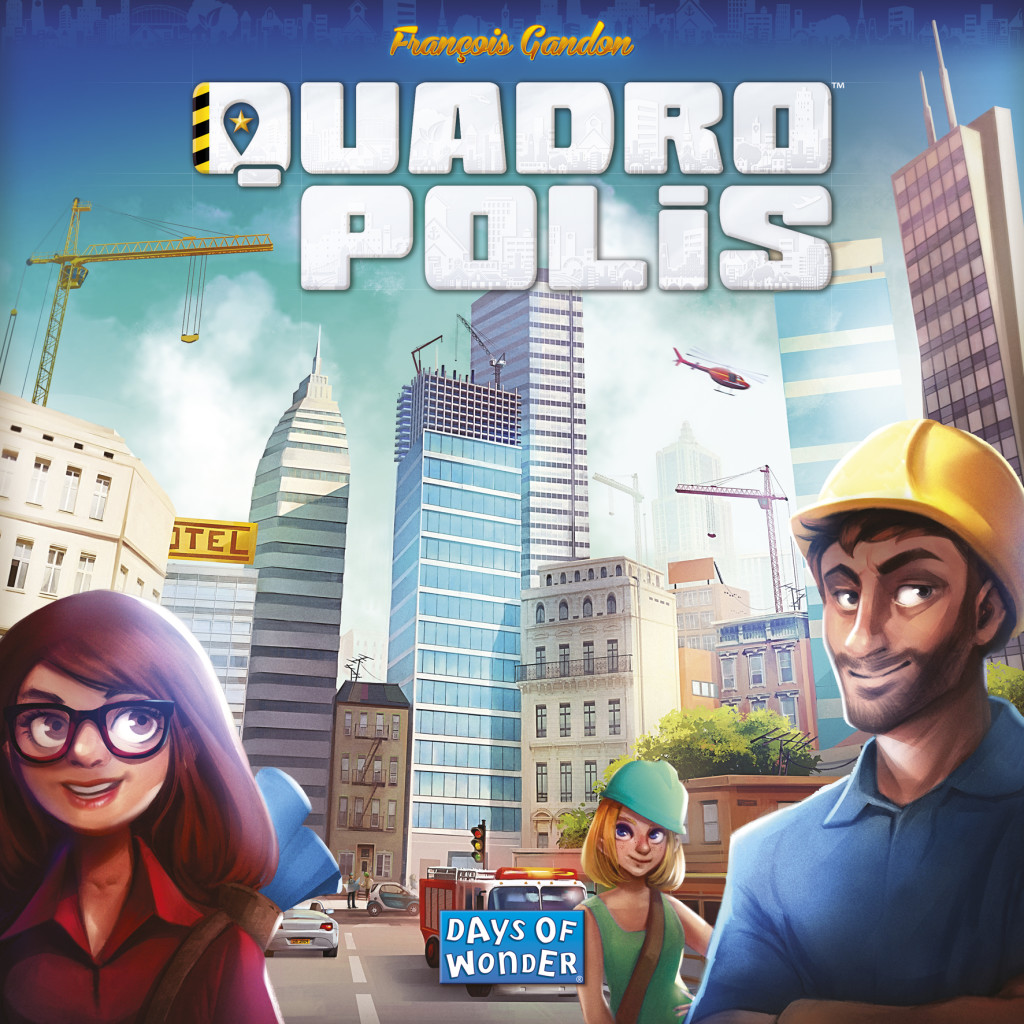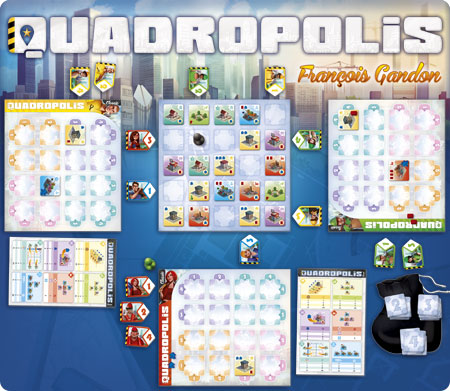Oh city builders, how I love thee. The real world might prevent me from bulldozing all of the houses on my street (except for mine, of course) and replacing them with nothing but soft-serve kiosks that are open 24/7…but in fantasy land, I can do whatever I want. While I may not be able to construct an ice cream empire in “Quadropolis”, I can construct a small city and power/man it almost any way I’d like to. The catch is that each type of building (towers, shops, factories, etc.) score differently based on where they are and what’s around them. So ready your architects, because we’re going to be building stuff!

Quadropolis: 2-4 Players, Ages 8+, Average Play Time = 30-60 Minutes
Components
The game includes 1 construction site board (5×5 grid), 4 double-sided player mats (classic/expert modes), 142 building tiles, 20 architects, 1 urbanist pawn, 65 inhabitant meeples, 1 mayor pawn, 50 energy cylinders, 1 scoring pad, 4 player guides, 1 rulebook, 1 cloth bag, and a manual.
Setup & Gameplay
The game has two modes: classic and expert. To keep things moving, I’ll opt to briefly touch on the rules associated with the classic mode.
Each player gets a player mat, a player guide, and four architects of their color (numbered 1-4). The buildings are sorted by number (1-4), face-down. The construction site goes in the middle of the table with the resources (inhabitants & resources) placed nearby. A starting player is chosen at random and gets the mayor pawn.
The game is played over four rounds. For each round, you’ll use one of the four stacks of building tiles, starting with the 1’s. The instructions say to use the cloth bag to lay the 1’s out for the first round, but it’s easier to omit the bag and create four face-down stacks. For the first round, take the 1’s and randomly place them face down on the construction site so that 25 tiles are present. Then, based on the number of players, remove tiles as appropriate (in a two player game for example, remove the tiles that say 3-4 and 4).
On a player’s turn, they’ll:
1. Take a building from the construction site. To do this, they’ll lay one of their four architects down on any of the four sides of the grid, then count in that many spaces as listed on the architect. An architect cannot be placed on top of another, nor can it point to the urbanist.
2. Move the urbanist to the space of the tile that was just taken.
3. Place the building in their city. They must place the tile on either the matching numbered row or column displayed on the architect played (if you played a 3 architect, then the building tile must be placed on either the 3rd column or 3rd row of your city).
4. Receive the resources listed on the top left of the building tile. If you couldn’t place your building and are thus forced to discard it, then you don’t receive the resources.
Players are free to allocate resources onto their buildings to activate them and further, move them around as need be until the game ends (they are not locked in to any one tile). Buildings that aren’t activated at the end of the game do not score and having excess resources will cause players to lose points.
Turns continue until players have played their four architect tiles, ending the round. To start a new round, the construction board is cleared and the #2 building tiles are laid out like the #1’s were. When the fourth round is over, players count up their victory points and the player with the most, wins!
Editor’s Note: The above doesn’t cover all of the rules found in the manual, but should give you an idea as to how the game is played.

The Review
The components are well done and more impressively, the game is quick and easy to play. Most city builders take a while to master…”Suburbia“, for example, has a TON of tile effects that make things pretty complicated toward the end of the game. Here, you’ll be thinking more about which buildings to go for and where to place them for maximum points as opposed to trying to remember that “X” tile will give you double points for every “Y” tile you have. In other words, the scoring system is a bit simpler, despite the fact that each building type has its own way of scoring. Tower tiles, for example, like to be stacked whereas wharfs like to be placed next to each other in a continuous line.
The resources are a nice touch too and I like the balancing act required to keep your score in check. By not having enough resources, some of your tiles won’t score. Have too much, and you’ll lose points for each excess resource you have. This can be hard to do, what with you and your opponents fighting over row and column spaces outside the grid…not to mention the urbanist, who prevents an architect from being played in a way to where they’d point to it. The architects are numbered one through four, so you’ll have to plan ahead and figure out which tiles to go for at the beginning of every round and hope you aren’t blocked mid-round by the other players.
Simply put, Days of Wonder has done it again…that is, make an excellent and engaging game that will no doubt be a competitor for the 2016 DGA awards coming later this year. I picked it up on the Miniature Market website for about $47 with shipping, though the MSRP seems to be a consistent $49.99. A little pricey for my tastes I’ll admit, though my weakness for city builders got the best of me. If you enjoyed the simplicity of “City Tycoon“, then by all means grab this game too.
Final Verdict: 9/10
—
